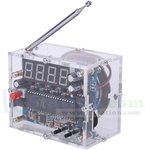DC 4.5V-5.5V 87.0MHz-108.0MHz Wireless FM Radio Receiver DIY Kit.
* Built-in 4-Bit red digital tube display.
* Built-in 5W power amplifier.
* Built-in volume adjustment.
* Automatically search for radio stations.
* Automatic memory function after power off.
* Power saving mode with backlight off for 5 seconds.
http://www.icstation.com/870mhz-1080mhz-wireless-radio-recei…
5pcs 5V 1A Micro USB Lithium Battery Charging Board TP4056 Charger Module
https://www.icstation.com/5pcs-micro-lithium-battery-chargin…
Tips:
ICStation offer free shipping for order reached US$20 (around AU$25.89).
All orders will be shipped via insurance tracking number service. Delivery time: 2-4 weeks


Looks cool. Im going to grab one